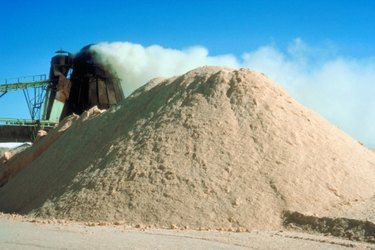
A form of engineered wood, particle board was first developed in Germany by Max Himmelheber after World War II. Before that time sawdust and wood shavings were used only as fuel, but the invention of particle boards gave wood byproducts a new purpose. Particle boards are produced in many thicknesses, and are commonly used for furniture parts and insulation for walls and floors.
Refining Wood Residue
Video of the Day
Sawdust is often mixed with other remnant pieces of wood to create a sheet of particle board. The most common particles are wood chips, shavings and flakes, which are often gathered from lumber mills, and brought in their raw state to the particle board manufacturer. The sawdust is sifted, and each particle is housed separately in accordance with its size.
Video of the Day
Mixing and Drying
The wood materials are mixed with the sawdust in a large, cylindrical machine. The dust is combined with even proportions of the other wood particles so that each board has a similar composition of wood materials. The mixing machine also dehydrates the wood particles. Large factory machines can be calibrated as high as 1,600 degrees and extract up to 60 tons of water per hour.
Binding Ingredients
The sawdust and mixed particles are sprayed with a formaldehyde-based resin, such as urea-formaldehyde or phenol-formaldehyde, which helps bind them together. Waxes are also added to help waterproof the final product. Other binding ingredients can include fireproofing agents and pesticides to deter termites and other insects.
Sheets
The resin mixture is laid out evenly, approximately three times the thickness of the actual board. Smoothing the surface with rollers helps ensure that the board will be the same density throughout as the wood is created in one continuous mat. Pressure is applied to wood, along with hot steam (approximately 360 degrees), which helps melt the resins and compress the particles.
Finishing
Final touches include buffing, cutting and laminating. Rollers or finishing plates are used to buff and sand the wood before it is cut into standard dimensions, 8 to 10 feet wide by 24 feet long. Afterward, the boards can also be laminated or finished with a veneer, which is a thin paper covering that imitates real wood. Finished boards are packed and stored until shipment.